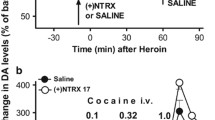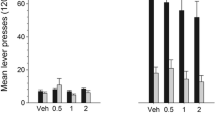Abstract
The purpose of the present study was to examine the effects of the 5-HT3 antagonists ondansetron and MDL72222, and the 5-HT releaser and reuptake inhibitor dexfenfluramine, on intravenous heroin self-administration by Wistar rats. Using separate squads of animals, two separate schedules of heroin reinforcement were used; a relatively low dose (0.03 mg/kg per infusion) made available under a FR5 schedule for 1 h each day, and a moderate heroin dose (0.1 mg/kg per infusion) available under a FR1 schedule for 2 h each day. Following the acquisition of stable levels of responding across days, both naloxone pretreatment (0.25 mg/kg SC) and halving the heroin infusion dose produced increases in operant responding for heroin at each concentration. Neither ondansetron (0.01–1 mg/kg SC) nor MDL72222 (0.1–3 mg/kg SC) pretreatment influenced heroin self-administration. Chronic treatment (5 day) of ondansetron (0.01–0.1 mg/kg) was similarly ineffective. However, dexfenfluramine (0.5–2.5 mg/kg IP) consistently reduced heroin self-administration at doses producing only modest decreases in food responding. These findings are in contrast to place conditioning studies, which show that 5-HT3 antagonists but not indirect 5-HT agonists block a morphine-induced place preference. Reasons for such discrepancies remain to be determined.
Similar content being viewed by others
References
Blundell JE (1986) Serotonin manipulations and the structure of feeding behaviour. Appetite 7:39–56
Bozarth MA, Wise RA (1981) Heroin reward is dependent on a dopaminergic substrate. Life Sci 29:1881–1886
Canadian Council of Animal Care (1980) Guide to the care and use of experimental animals. Ottawa, p 84
Carboni E, Acquas E, Leone P, DiChiara G (1989) 5-HT3 receptor antagonists block morphine- and nicotine- but not amphetamine-induced reward. Psychopharmacology 97:175–178
Carr GD, Fibiger HC, Phillips AG (1989) Conditioned place preference as a measure of drug reward. In: Liebman JM, Cooper SJ (eds) The neuropharmacological basis of reward. Oxford University Press, Oxford, pp 264–319
Carroll ME, Lac ST, Asencio M, Kragh R (1990) Fluoxetine reduces intravenous cocaine self-administration in rats. Pharmacol Biochem Behav 35:237–244
Corrigall WA (1992) A rodent model for nicotine self-administration. In: Boulton A, Baker G, Wu P (eds) Neuromethods, vol. 24: Animal models of drug addiction. Humana Clifton, M. J. pp 315–344
Corrigall WA, Coen KM (1991) Cocaine self-administration is increased by both D1 and D2 dopamine antagonists. Pharmacol Biochem Behav 39:799–802
Costall B, Domeney AM, Naylor RJ, Tyers MB (1987a) Effects of the 5-HT3 receptor antagonist, GR38032F, on raised dopaminergic activity in the mesolimbic system of the rat and marmoset brain. Br J Pharmacol 92:881–894
Costall B, Domeney AM, Naylor RJ, Tyers MB (1987b) Inhibition by 5-HT3 antagonists of hyperactivity caused by dopamine infusion into the rat accumbens. Br J Pharmacol 93:194P
Crowder WF, Smith SG, Davis WM, Noel JT, Coussens WR (1972) Effect of morphine dose size on the conditioned reinforcing potency of stimuli paired with morphine. Physiol Rec 22:441–448
Davis WM, Smith SG (1987) Conditioned reinforcement as a measure of the rewarding properties of drugs. In: Bozarth MA (ed) Methods of assessing the reinforcing properties of abused drugs. Springer, New York, pp 199–210
DeWitt H, Stewart J (1983) Drug reinstatement of heroin-reinforced responding in the rat. Psychopharmacology 79:29–31
Ettenberg A, Pettit HO, Bloom FE, Koob GF (1982) Heroin and cocaine intravenous self-administration in rats: mediation by separate neural systems. Psychopharmacology 78:204–209
Fuller RW, Snoddy HD, Robertson DW (1988) Mechanism of effects ofd-fenfluramine on brain serotonin metabolism in rats: uptake inhibition versus release. Pharmacol Biochem Behav 30:715–721
Grignaschi G, Samanin R (1992) Role of serotonin and catecholamines in brain in the feeding suppressant effect of fluoxetine. Neuropharmacology 31:445–449
Hagan RM, Jones BJ, Jordan CC, Tyers MB (1990) Effect of 5-HT3 receptor antagonists on responses to selective activation of mesolimbic neurones. Br J Pharmacol 99:227–232
Haraguchi M, Samson HH, Tolliver GA (1990) Reduction in oral ethanol self-administration in the rat by the 5-HT uptake blocker fluoxetine. Pharmacol Biochem Behav 35:259–262
Higgins GA, Joharchi N, Nguyen P, Sellers EM (1992a) Effect of the 5-HT3 receptor antagonists, MDL72222 and ondansetron on morphine place conditioning. Psychopharmacology 106:315–320
Higgins GA, Tomkins DM, Fletcher PJ, Sellers EM (1992b) Effect of drugs influencing 5-HT function on ethanol drinking and feeding behaviour in rats: studies using a drinkometer system. Neurosci Biobehav Rev 16:535–552
Higgins GA, Corrigall WA, Joharchi N, Sellers EM (1993a) Effect of 5-HT3 receptor antagonists on the discriminative and reinforcng properties of opioids. Br J Pharmacol 108:105P
Higgins GA, Wang Y, Sellers EM (1993b) Preliminary findings with the indirect 5-HT agonist dexfenfluramine on heroin discrimination and self-administration in rats. Pharmacol Biochem Behav 45:963–966
Hubner CB, Koob GF (1990) The ventral pallidum plays a role in mediating cocaine and heroin self-administration in the rat. Brain Res 508:20–29
Koob GF, Bloom FE (1988) Cellular and molecular mechanisms of drug dependence. Science 242:715–723
Koob GF, Goeders NE (1989) Neuroanatomical substrates of drug self-administration. In: Liebman JM, Cooper SJ (eds) The neuropharmacological basis of reward. Oxford University Press, Oxford, pp 214–263
Koob GF, Pettit HO, Ettenberg A, Bloom FE (1984) Effects of opiate antagonists and their quaternary derivatives on heroin self-administration in the rat. J Pharmacol Exp Ther 229:481–486
Koob GF, Vaccarino FJ, Amalric M, Bloom FE (1987) Positive reinforcement properties of drugs: search for neural substrates. In: Engel J, Oreland L (eds) Brain reward systems and abuse. Raven, New York, pp 35–50
Kruszewska A, Romandini S, Samanin R (1986) Different effects of zimelidine on the reinforcing properties ofd-amphetamine and morphine on the conditioned place preference in rats. Eur J Pharmacol 125:283–286
Leccese AP, Lyness WH (1984) The effects of putative 5-hydroxytryptamine receptor active agents ond-amphetamine self-administration in controls and rats with 5,7-dihydroxytryptamine median forebrain bundle lesions. Brain Res 303:153–162
Peroutka SJ (1993) 5-Hydroxytryptamine receptors. J Neurochem 60:408–416
Petitt HO, Ettenberg A, Bloom FE, Koob GF (1984) Destruction of dopamine in the nucleus accumbens selectively attenuates cocaine but not heroin self-administration in rats. Psychopharmacology 84:167–173
Phillips AG, LePaine FG, Fibiger HC (1983) Dopaminergic mediation of reward produced by direct injection of enkephalin into the ventral tegmental area of the rat. Life Sci 33:2505–2511
Pulvirenti L, Maldonado-Lopez R, Koob GF (1992) NMDA receptors in the nucleus accumbens modulate intravenous cocaine but not heroin self-administration in the rat. Brain Res 594:327–330
Richardson NR, Roberts DCS (1991) Fluoxetine pretreatment reduces breaking points on a progressive ratio schedule reinforced by intravenous cocaine self-administration in the rat. Life Sci 49:833–840
Rowland NE, Charlton J (1985) Neurobiology of an anorectic drug: fenfluramine. Prog Neurobiol 27:13–62
Rowland NE, Morian KR (1992) Effect of dexfenfluramine on alcohol intake in alcohol-preferring P-rats. Alcohol 9:559–561
Smith JE, Shultz K, Co C, Goeders NE, Dworkin SI (1987) Effects of 5, 7-dihydroxytryptamine lesions of the nucleus accumbens on intravenous morphine self-administration. Pharmacol Biochem Behav 26:607–612
Spyraki C, Fibiger HC, Phillips AG (1983) Attenuation of heroin reward in rats by disruption of the mesolimbic dopamine system. Psychopharmacology 79:278–283
Spyraki C, Nomikos GG, Galanopoulou P, Daifotis Z (1988) Drug-induced place preference in rats with 5, 7-dihydroxytryptamine lesions of the nucleus accumbens. Behav Brain Res 29:127–134
Stewart J, DeWitt H (1987) Reinstatement of drug-taking behaviour as a method of assessing incentive motivational properties of drugs. In: Bozarth MA (ed) Methods of assessing the reinforcing properties of abused drugs. Springer, New York, pp 211–227
Vaccarino FJ, Bloom FE, Koob GF (1985) Blockade of nucleus accumbens opiate receptors attenuates intravenous heroin reward in the rat. Psychopharmacology 86:37–42
Wise RA, Bozarth MA (1987) A psychomotor stimulant theory of addiction. Psychol Rev 94:469–492
Wong DT, Reid LR, Threlkeld PG (1988) Suppression of food intake in rats by fluoxetine: comparison of enantiomers and effects of serotonin antagonists. Pharmacol Biochem Behav 31:475–479
Author information
Authors and Affiliations
Rights and permissions
About this article
Cite this article
Higgins, G.A., Wang, Y., Corrigall, W.A. et al. Influence of 5-HT3 receptor antagonists and the indirect 5-HT agonist, dexfenfluramine, on heroin self-administration in rats. Psychopharmacology 114, 611–619 (1994). https://doi.org/10.1007/BF02244992
Received:
Revised:
Issue Date:
DOI: https://doi.org/10.1007/BF02244992




